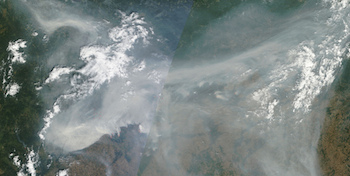
Q: You believe that we should be paying even more attention to indirect impacts of climate change on and through commercial forestry. What kind of indirect impacts are we talking about?
A: An indirect climate change impact is an impact felt in one location or by one actor as a result of a direct climate change impact elsewhere. SEI has developed a framework that distinguishes four main pathways for transfer of indirect climate impacts: biophysical, trade, migration and finance.
In forestry, one finance example is the effect on international market prices of both timber and wood pellets from massive insect infestations in Canadian forests. This has implications for Swedish forestry, as well as for a number of sectors that rely on these commodities.
Another example is forest fires, which are expected to become more frequent in the boreal region with climate change. While the fires are a direct climate change impact, they can have major indirect impacts – including, for example, health problems due to the smoke sometimes hundreds of miles away. This would be considered an indirect impact via a biophysical pathway.
Whether indirect impacts are more or less serious than the direct impacts is highly dependent on location. However, it is safe to say that the indirect impacts have not been analysed to anything like the same extent as direct impacts. In addition, once we include indirect impacts it opens up an entirely new level to analysis of forests climate change impacts that stretches far beyond climate science and into economics, complexity theory and geopolitics.
Q: Which Swedish forestry actors have you talked to, and how aware were they of the risks from indirect climate change impacts?
A: We have been in dialogues with people from various segments of the Swedish forestry sector for several years, especially thanks to numerous projects under the Mistra-SWECIA programme. I would say that there is very little knowledge about indirect climate change impacts as a concept – even though many stakeholders are already taking action in response to some individual indirect impacts. For example, the Swedish forestry industry is taking advantage of a growing market for cellulose fibres for use in textiles and clothing. This market has grown partly because while demand for textiles and clothing is increasing, the expansion of cotton cultivation is limited due to its resource intensity and to difficulties linked to warming climate in some key producing regions.
Q: What needs to happen to ensure more appropriate, timely responses to indirect impacts?
A: We first need to raise awareness that of indirect impacts as an issue. In this globalized and interconnected world, it’s no longer enough to ask ‘how does climate change affect my region?’ You also need to ask ‘How is my region affected by climate change elsewhere?’ It’s one thing to adapt to individual indirect impacts, but to formulate proactive policies you need to see them as part of the larger picture. But this requires making explicit the complexity of the global economic system, particularly how it transfers the impacts of climate change and other factors, and how we can reduce vulnerability and build resilience. SEI is developing a new initiative to elaborate our understanding of global producer to consumer systems, factoring in such indirect climate change impacts, geopolitical relations, and other aspects of sustainability.
Olle Olsson will be presenting on this topic in session A-30 (37) of the IUFRO World Congress, Achieving Policy Integration Across Fragmented Domains: Forest Policy Perspectives, 6 October, 3.30–6.00 pm, Room 150 D.
Design and development by Soapbox.